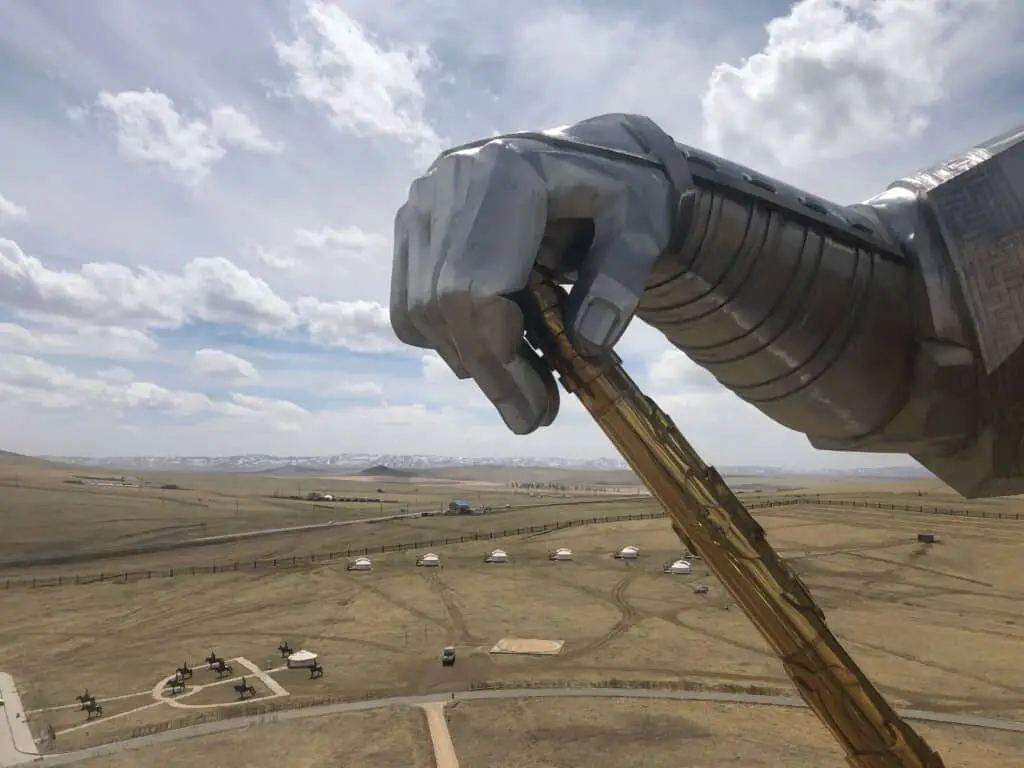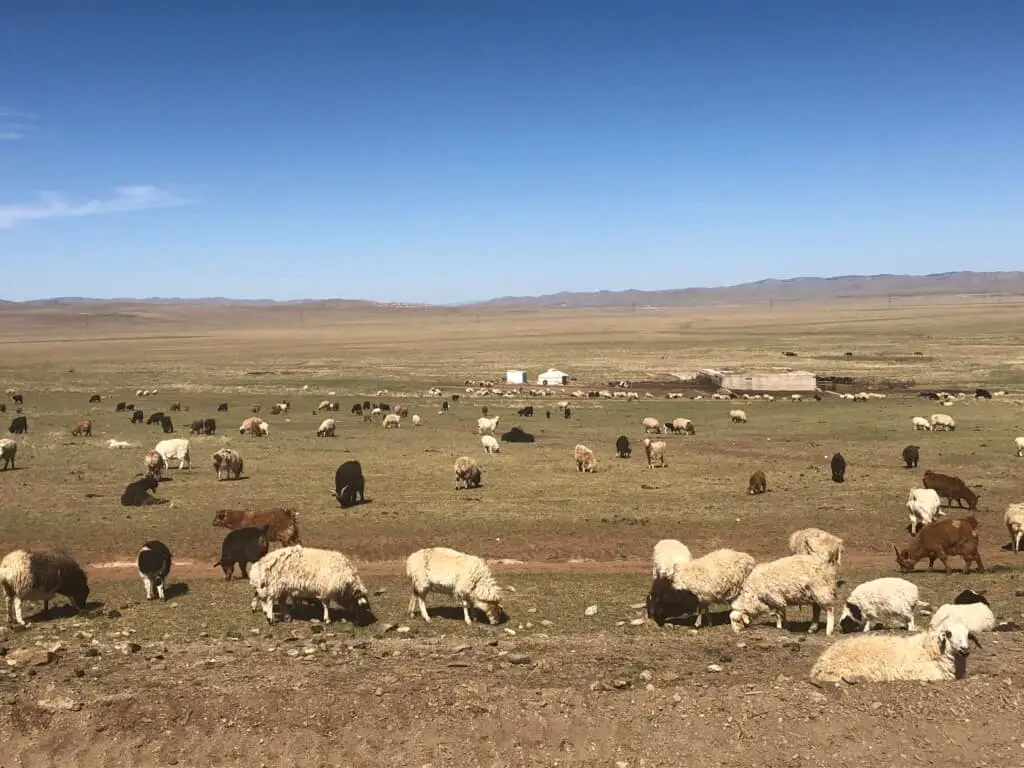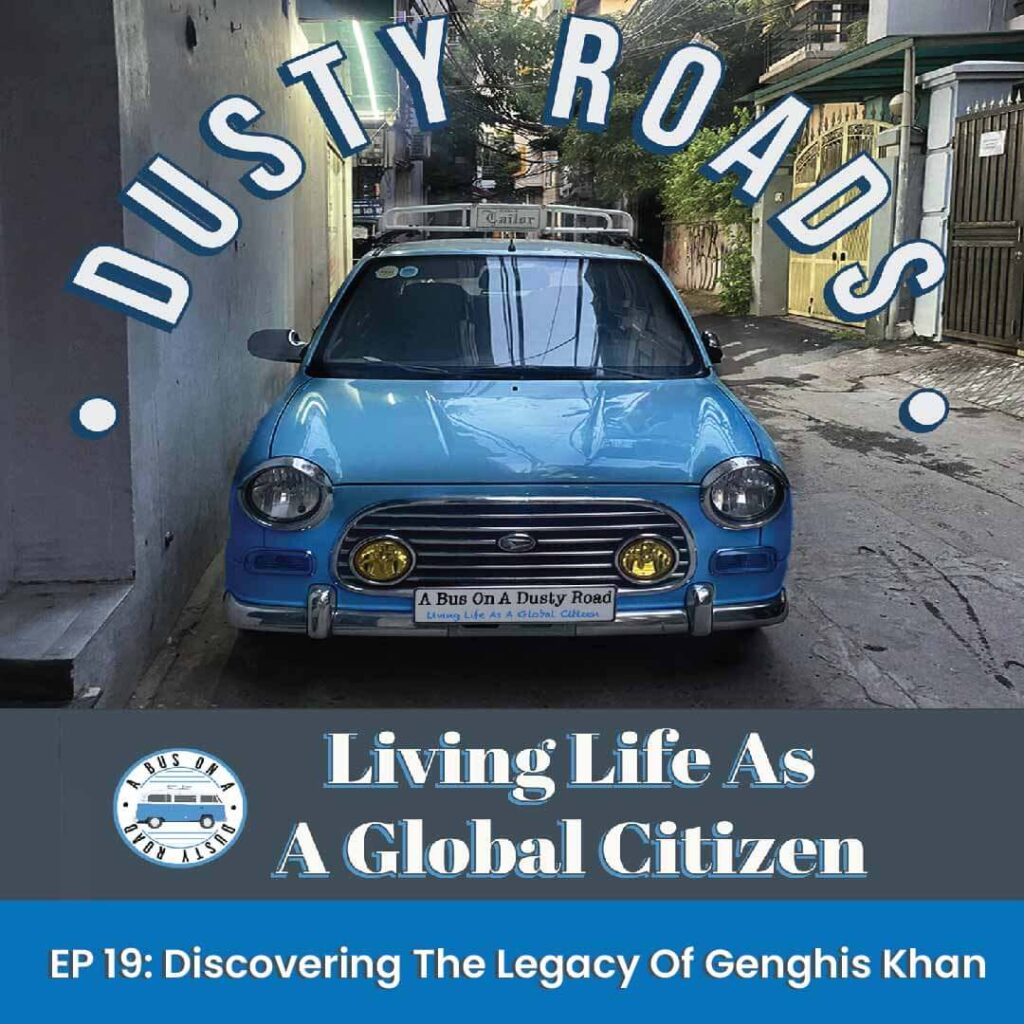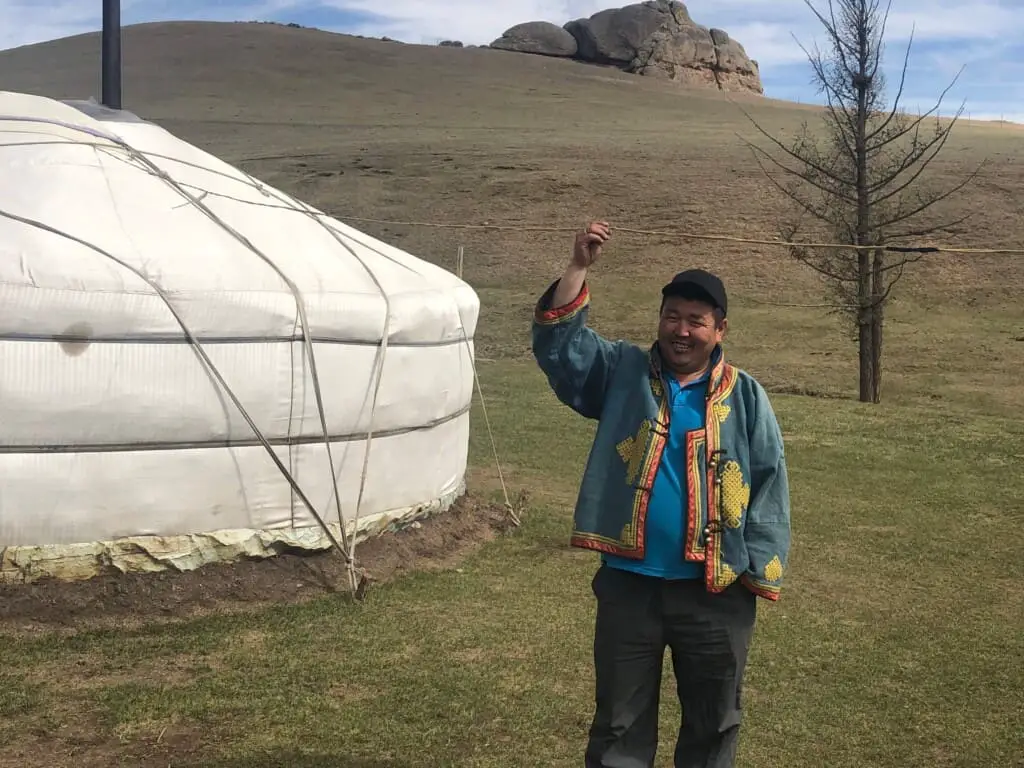Outside Ulaanbaatar, Mongolia is a huge statue of Genghis Khan. The Genghis Khan Statue is an amazing tribute to Genghis Khan. I had the chance to visit the Genghis Khan Statue complex outside Ulaanbaatar, Mongolia, and was inspired by its size, location, and symbolism.
The Genghis Khan Statue Complex is outside Ulaanbaatar, Mongolia. This statue commemorates the Mongolian leader, Genghis Khan, who ruled Mongolia in the early 1200s. Despite his challenging childhood, Genghis Khan rose to become one of his time’s greatest and most powerful leaders. Genghis Khan and his army conquered many parts of the world, including part of China, to the present-day Capsian Sea area.
Table of Contents
- Mongolia’s Genghis Khan Statue – Chinggis Khan Statue Complex
- Genghis Khan: The Conqueror Who Shaped the World
- Related Questions
Mongolia’s Genghis Khan Statue – Chinggis Khan Statue Complex
The Genghis Khan Statue, also known as the Genghis Khan Equestrian statue or Chinggis Khan Statue Complex, is a 131-foot (40-meter) tall statue of Genghis Khan on horseback. The statue is located on the Tuul River bank about 54 kilometers or (33.5 miles) east of the Mongolian capital, Ulaanbaatar.
The Genghis Khan Statue was completed in 2008; sculptor D. Erdenebileg and architect J. Enkhjargal designed it. The complex, at the time, cost USD 4.1 million. The statue used 250 tons of steel for its building.
As one Mongolian, Sanchir Erkhem, a Mongolian Sumo wrestler living in Japan, summed up how the Mongolians felt about Genghis Khan. He said this to the New York Times while posing for photos outside the Genghis Khan statue:
“All Mongolian people are proud of this statue…Genghis Khan is our hero, our father, our god.”
Sanchir Erkhem – New York Times
The statue sits high on a hill, symbolically pointing east toward Genghis Khan’s birthplace. When you visit the statue, you can see the following:
- Statue Base – At the statue base, there may be vendors offering camel or horseback riding; you can try your luck with having a Mongolian eagle sit on your arm.
- Visitors’ Center – The bottom of the statue has a visitors’ center where you can learn a bit more about the statue and Genghis Khan. The visitor’s center is 10 meters (33 feet tall) and has 36 columns. Each column respects the 36 Mongolian khans, from Genghis Khan to Ligdan Khan.
- Restaurant, Museum, Souvenir Shop, and Conference Hall – There is also a restaurant, souvenir shop, museums, and conference hall. The museums show some artifacts from everyday life during the time of Genghis Khan.
- ViewPoint Station – On the top of the statues, you can go up by elevator or stairs to see a panoramic view of the entire area. It is a magnificent view and gives you a feel of Mongolia’s amazing landscape.

Genghis Khan: The Conqueror Who Shaped the World
In the annals of history, few figures loom as large and enigmatic as Genghis Khan. Born in the harsh steppes of Mongolia, he rose from humble beginnings to establish the largest contiguous empire the world has ever known. His name is synonymous with conquest, innovation, and a complex legacy that continues to spark debate and fascination.
We will delve into the life of Genghis Khan, unraveling the layers of myth and reality to understand the man behind the legend. From his early life of adversity to his remarkable military strategies and governance, we journey through the life of a leader who forever altered the course of world history. Join us as we traverse the extraordinary tale of Genghis Khan, a figure whose impact resonates through the ages.
What Was Genghis Khan’s Early Life Like?
Genghis Khan’s original name was Temujin, also spelled Temuchin. The name Temujin meant “of iron” or “blacksmith.”
Genghis Khan was born in north-central Mongolia in about 1162. Young Genghis and his family were members of the Borjigin tribe and were descendants of Khabul Khan; Khabul Khan briefly united the Mongols against Jin (Chin) Dynasty in the early 1100s.
Folklore says that Genghis was born with a blood clot in his hand. In Mongolian culture, a child born with a blood clot was thought to sign that the child was destined to be a leader.
When Genghis was only nine years old, a rival clan poisoned his father; this left his mother alone to raise her seven children alone. At the time of his father’s death, Genghis claimed himself as a clan chief instead of his father.
The clan refused to accept Genghis as their clan leader; shortly after, the clan expelled his family, leaving his mother to raise her seven children alone and without support.
Genghis Khan’s mother taught him the importance of having the right alliances. His mother taught him the grim reality of living in a constantly turbulent society like the Mongol society.
Because of the very rough beginnings of his life, he grew up hunting and foraging his way to survive at all costs. There is a story that says Genghis may have even murdered his half-brother in a dispute over food.
At age 16, Genghis married Borte from another clan; this marriage helped cement his alliance with the Konkirat clan. But soon after their marriage, Borte was kidnapped by the Merkit clan and given to the chieftain as another wife.
Genghis was able to rescue his wife soon after she gave birth to her first son. We are not sure if the son was Genghis’s son or the son of the Merkit clan chieftain, but Genghis accepted him as his own.
Borte and Genghis had four sons. As it was the Mongolian custom to have several wives, he also had many other children with other Mongolian wives. Only Borte’s male children qualified for succession in the family.
Genghis showed himself as an exceptional warrior and leader at a very young age. He was able to amass an army of supporters and understood the importance of alliances with other important clans. By 1206, he consolidated his Mongol power to focus on outside conquests.

How Did Genghis Khan Come To Power?
In 1206 an assembly of leaders declared Genghis Khan the universal emperor (Chinggis khan) of the Mongolian Stepp. The Mongolian Stepp is located throughout most of present-day Mongolia.
It can be said that Genghis Khan could understand the importance of alliances at a very young age, which helped him to be able to amass his power base. He also exterminated any existing clan nobility he conquered and overpowered the enemies until he could consolidate his power base.
Genghis Khan was known to have a very keen eye for talent, even talent he saw in his own sworn enemies. Genghis promoted his officers not on ancestry, class, or other allegiances but on their talent and skills.
There is a story about a battle in 1201 between Genghis Khan and the rival Taijut clan; Genghis was nearly killed after his horse was shot from under him with an arrow. When he later spoke to the Taijut clan prisoners, he asked who had shot his horse with the arrow. One brave prisoner admitted that he was responsible.
Genghis was so impressed with the soldier who had shot him that he made him an officer in his army and nicknamed him “jebe” or “arrow” to honor their first meeting on the battlefield. Jebe became one of the greatest field commanders for Genghis Khan’s conquests of Asia and Europe.
During his conquests, Genghis Khan gave other kingdoms a chance to submit to Mongol rule peacefully. If they did not, he did not hesitate to bring down the sword on any society that refused.
Many historians believe that under the leadership of Genghis Khan during the Mongol conquests, as many as 40 million people may have died. To put into perspective the brutality of these Mongol conquests, some historians estimate that the entire world’s population dropped 11% during the Mongol battles and conquests.
Listen To Our Podcast About Discovering
The Legacy Of Genghis Khan, below or by clicking here.

What Was Genghis Khan Best Known For?
Genghis Kham was best known for unifying the Mongolian steppe or Mongolian territory into on massive empire. He is known for conquering part of China under the powerful Jin (Chin) Dynasty. Genghis Khan and his army also captured territory as far west as the Caspian sea.
Here are some other less-known facts about Genghis Khan:
- Religious Tolerance – Unlike many other empire builders, Genghis Khan believed in the diversity of religion for his newly conquered territories. He passed laws to allow tax exemptions for places of worship and freedom of religion. This came from the belief that happy people were less likely to rebel.
- Created One of The First Postal Services – Along with their bows and arrows to conquest other places, the Mongols also had a vast communication network. This network included a mounted courier known as “Yam.” This courier network was a well-organized group of riders. Many of these riders would travel 200 miles a day. This sophisticated communication system helped give the Mongol army some strategic advantages.
- Did Not Believe in Torture – The Mongols did not purposely maim or torture their prisoners; instead, they believed in speed and efficiency in battle. In other words, they fought to kill.
- Brought Enemies Into His Army – One way the Mongols increased their Army was they often absorbed or brought their enemies in as soldiers and fought alongside them.
- Left Cities Alone – Once he had conquered a city, the Mongols would leave their officials there to rule the city and expected the people to get on with their everyday lives. In other words, they would leave these people alone to live their lives as they had been living before – except now with some new government minders.
- Outlaw Slavery – Genghis knew firsthand about the terrors of slavery, so he outlawed all kinds of slavery.
- Established Laws – Genghis Khan established a Mongol common law called “Yassa.” It prohibited theft, adultery, blood feuds, and bearing false witness.
- Universal Writing System – Genghis Khan ordered the creation of a writing system based on the Uyghur alphabet. He saw this as a way to help him enforce his law; this writing system was widely taught.
- Free Trade – Genghis Khan believed in free trade and using trade to gain knowledge (he had spies as merchants) and saw trade as a unifying force.
- Redistributed Wealth – Genghis Khan was extremely wealthy. He had conquered a lot of lands. But rather than hoard the land, money, and goods he gained through conquering, he gave freely to the soldiers and commanders. This ensured their loyalty and that they did not loot without permission.

When Did Genghis Khan Die?
No one knows how Genghis Khan died or exactly where he is buried. There are still many rumors as to how he died. The most well-known rumor says he died in 1227 from injuries due to a fall from a horse. Other sources say he died of malaria, an arrow in the knee, or was murdered while trying to force himself on a Chinese princess.
Where he is buried is as much a mystery as how he died. Genghis Khan took great pains to keep his final resting place a secret. According to some legend, his funeral procession slaughtered anyone that came in contact with it. Even on this journey to his final resting place, people were killed to ensure silence.
Folklore says that those involved in the funeral procession rode horses over his grave to conceal it. Genghis Khan’s most likely resting place is around the Mongolian mountain called Burkham Khaldun.
Genghis Khan is an enigmatic historical character. There’s no doubt that his conquests were brutal as so many people died, but on the other hand, he also instituted many policies that were very forward-thinking for his time. So no matter what you may think about Genghis Khan, one thing for certain is that he was an amazing leader who could rally his army and others behind him.
At A Bus On A Dusty Road, we talk about travel, life, and ex-pat living. We are all about “Living Life As A Global Citizen.” We explore social, cultural, and economic issues and travel.
We would love to have you be part of our community. Sign up for our newsletter to keep up-to-date by clicking here. If you have any questions, you can contact me, Anita, by clicking here.
Listen to our Podcast called Dusty Roads. You can find it on all major podcast platforms. Try out listening to one of our podcasts by clicking here.
Subscribe to our A Bus On A Dusty Road YouTube Channel filled with great videos and information by clicking here.
Related Questions
What is Mongolian Throat Singing Called?
Mongolia has a long tradition of Mongolian Tuvan throat singing. This kind of singing is an overtone kind of cultural music where singers sing more than one pitch simultaneously. There are four types of throat singing Khoomei, Khorekteer, Sygyt, and Kargyraa throat singing. Each type of throat singing has a unique sound. The Mongolian rock’n’roll band Hu has combined Mongolian throat singing and traditional Mongolian instruments with rock’n’roll. The Hu and their music continue to gain popularity as they perform with some top rock’n’roll names.
You can find out more by reading our blog, What is Mongolian Throat Singing Called? Mongolian Tuvan Throat Singing by clicking here.
Why You Should Bring Binoculars On Your Trip to Mongolia?
When traveling to Mongolia, a lightweight pair of binoculars is an essential item to pack. By having binoculars, you should be able to see much further than with your naked eye. Pack a pair of binoculars in your suitcase to get the most out of your Mongolian adventures.
You can find out more by reading our blog Why You Should Bring Binoculars On Your Trip To Mongolia? by clicking here.


